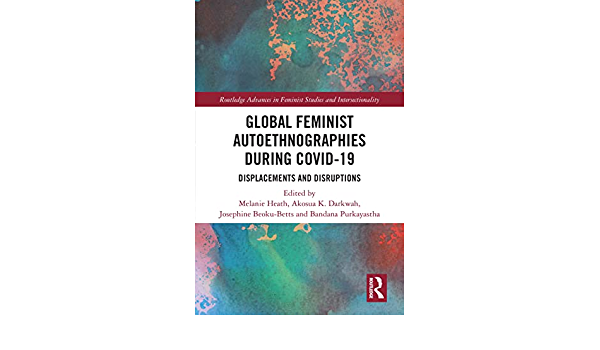
The book Global feminist autoethnographies during COVID-19: Displacements and Disruptions (published by Routledge in 2022) displays a wide collection of reflections on the contributors’ experiences of the COVID-19 pandemic. The collection makes a strong effort to represent the perspective of authors that hold very different positions within academia, ranging from students to tenure-track professors. They come from different geographical backgrounds, identify themselves with different sexual, gender and racialised categories of identity and have different income statuses. Across the chapters, the contributors consistently reflect on their positionalities and address the intersecting inequalities that emerge from the experience of the pandemic.
The backbone of the collection and its most valuable contribution is the author’s engagement with autoethnographic writing. As explained by the editors in the introduction, the term “autoethnography” is used “loosely” in the collection to “capture self-focused experiences that reveal structural realities from different parts of the world”. In the introduction, the editors make a strong point in justifying the necessity of avoiding imposing specific forms of knowledge on the authors’ different takes on autoethnography and to let the contributors “speak their truth, in their voices, and in the styles they prefer” (13). The feminist ground on which the collection is built is the acknowledgement that North-South power relationships often frame processes of knowledge production. In this framework, spaces for including different forms of knowledge need to be opened both within academia and in public debates. This translates into the inclusion of “abuelitas epistemologies”, “duoethnographies”, “knitting work” “collaborative autoethnographies” as different models of knowledge production that find space in the collection. The choice of producing autoethnographies also allows the authors to contest the distinction between public and personal spaces, making justice to the critical feminist argument that “personal is political” and underlying the relevance of “getting personal” (119) in their analysis of the pandemic.
Across the different chapters, all authors accepted the challenge to show themselves in their vulnerability as human beings going through a pandemic by engaging with the question of: “In what ways are we hurting?”. While in academic writing, the author often disappears and hides behind plain, impersonal and objective writing, in this collection, the contributors’ voices feel particularly honest. Several authors share their feeling of powerlessness, fear and anxiety before the different forms of racism that emerged before the pandemic (particularly in relation to the homicide of George Floyd in May 2020) and the racist micro-aggressions they faced, as Black scholars, scholars and students from Asian descendants, or migrants, during the pandemic. For others, vulnerability emerges from the experience of ageing, being sick, or being alone and kept away from family members and significant others living elsewhere. Particularly beautifully written are the experiences of vulnerability shared in chapter 18 by Shobha Hamal Gurung, who writes about the letters written to a distant son, to share all the feelings she could not share over a call and Edelweiss Murillo Lafuente’s description of how, as a student, she “stayed home and drank tea” while not having enough money for taking a test, while at the same time asking herself if she even belonged to the academic sphere (252).
The discussion, promoted by the contributors, of the challenges that people in academia face in relation to the unstructured, often precarious and low-paid nature of academic jobs is a timely and important one that is rarely discussed in academic spaces. The challenge of being “moterscholars” (162), conciliating paid and unpaid work and academic and reproductive labour emerges strongly from the collection, as well as the challenge of living, as students and scholars, “transnational lives” across borders and often away from one’s support network. The book is also strongly anchored on a feminist “ethics of care”, and, as argued by several authors, writing these pages also represented a way to take care of each other and heal, collectively, the wounds left by the pandemic.
At times, the editor’s loose grip on autoethnography makes some of the contributions feel repetitive. More engagement from the authors with the key concepts around which the collection is organised: (i) disruption, (ii) distress, and (iii) displacement is also missing in some chapters. On the other hand, in chapter 22, Nazanin Shahrokni offers an interesting reflection on how the pandemic challenged one’s experience of “home”, and in chapter 19, Melanie Heath poses the interesting question of “what is family?” (230) and how this concept may need updating.
Overall the book does a great job of offering a feminist and, therefore, also an inclusive and personal perspective on the pandemic. It leaves the reader with timely questions concerning the unequal challenges that the pandemic will pose for academia and society at large. It also suggests the possibility of not returning to normal but, as suggested by Esther Hernandez-Medina and Malak Afaneh in chapter 2 “instead create a new way of life that is inclusive and intersectional” (50).
***
Chiara Chiavaroli is a PhD student at the Department of International Development, London School of Economics and Political Science (LSE).